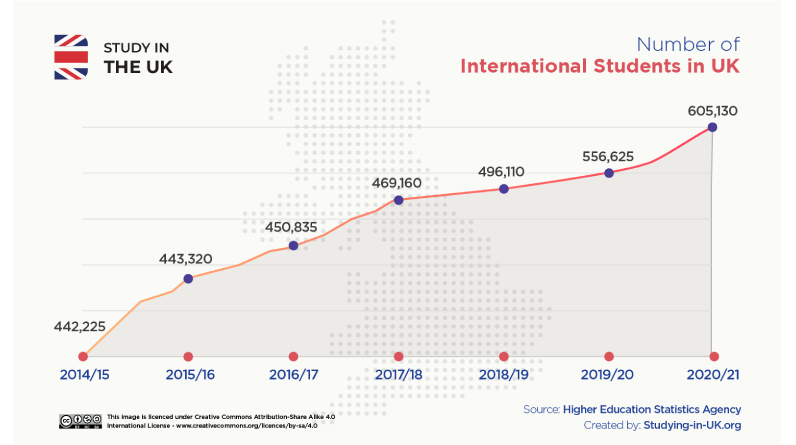Highest ever number of students studying in the UK

According to the most recent data from the United Kingdom’s Higher Education Statistics Agency (HESA), a record 151,690 Chinese students studied in the United Kingdom in 2021-22. This number far exceeded that of any other country or alliance, including the European Union.
Many Chinese students are interested in studying in the United Kingdom for a number of reasons, including what experts describe as the country’s prestigious university system and the fact that it is a relatively safe place to live. China’s tensions with the United States and Australia also benefit the United Kingdom.
According to HESA figures, the total number of Chinese students studying in the UK will increase by 44,475 (or 41 percent) between 2017–18 and 2021–22, and in the most recent enrollment year, Chinese students accounted for 27 percent of all non–European Union (non–EEA) students.
BE Education’s founder, William Vanbergen, who is also its CEO, made the following statement: “Chinese families have long placed a high value on education in the United Kingdom, and the country’s universities continue to enjoy this esteem. As a result of the rising political tensions in the United States, many hopeful applicants have begun looking for work in the United Kingdom instead.”
“When compared to other countries, the United Kingdom offers a competitive price and time (three years for undergraduate studies and one year for masters). After seeing the media coverage of so many gun crimes in the United States, many foreigners to the UK assume it is a safe place to live “Furthermore, he said.
According to Julian Fisher, a senior partner at the consultancy Venture Education, the increase in the number of Chinese students studying in the UK is in part due to the boom in English teaching in China over the past 20 years. This increase has coincided with the rise of internationally focused schools, summer camps, and after-school activities.
He claimed that these elements, in addition to China’s rising middle class, the difficulty of getting into a Chinese university, geopolitical tensions with the United States and Australia, and the relative stability and quality of the education system in the United Kingdom, were responsible for the increase.
In 2021-22, the number of Chinese students enrolled at HESA institutions surpassed the total number of EU students by 120,140, a drop of 21% from the previous year.
There was a precipitous 53% drop in first-year enrollments among EU residents from 2020–21 to 2021–22. Having the UK leave the EU and the international fee policy being revised on August 1, 2021, both lend support to such a reduction.

Education expert Susan Fang, who started the company OxBridge Holdings, said, “It’s just good economics. As supply and demand continue to fall, the number of EU students will continue to fall. At that point, the remaining students who are interested in enrolling are prepared to pay the higher prices.”
Fang explains that the United Kingdom will have a hard time attracting European students because “many European universities, such as those in the Netherlands and Ireland, offer degrees taught in English at a fraction of a UK degree’s price” and “well-resourced US universities offer generous scholarship packages to the most competitive students.”
Also Read :The UK High Court has ruled against Bahrain in a spyware case
In 2021-22, enrollment in the European Union fell while enrollment outside of the EU increased by 32% among first-year students.
There has been a notable increase of 106,200 Indian students studying in British universities over the past five years, making India the second largest source country of international students after China. About 23% of all non-EU students in the UK in 2021-22 were Indian. There were 1,126,535 of them.
Concerns have been voiced about becoming too reliant on the Chinese market because of the large number of Chinese students enrolled in UK universities.
“The best practise is to spread your resources out among several different options. It’s beneficial to both the student body and the teaching staff when the student body and staff can draw from a wide range of backgrounds and perspectives. However, our world is far from perfect “As Fang put it.
She argued that, if China remains the world’s largest source of self-funding international students, more resources should be directed towards maintaining the United Kingdom’s universities’ appeal to Chinese students.
On the other hand, “the way India has risen dramatically in these past three years, soon — if not already-UK higher education stakeholders will start worrying about being overreliant on Indian students,” Fang added.
Recent reports indicate that Britain’s Home Secretary Suella Braverman has drafted a plan to reform the graduate visa route, which may help explain the rise in the number of students enrolling in higher education in the UK.
According to Braverman’s plan, international graduates have six months to find work that qualifies them for a work visa or leave the United Kingdom.
According to Fisher, the effects on the Chinese won’t be as severe as on the Indians or the Nigerians. “Some nations, like India, place a much higher value on the post-study work visa work route than China does. Chinese participation is low when measured per person. The vast majority of Chinese students pursue higher education, and those who do typically have financial support from their families “That’s what he had to say, he clarified.
While the number of Chinese students studying in the UK has increased over the years, he said that trend will soon level off.
Leave a reply
You must be logged in to post a comment.








